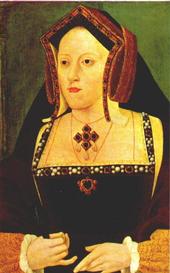Born in Alcalá de Henares, I was the youngest surviving child of Ferdinand II of Aragon and Isabella I of Castile and, as a great-great-granddaughter of John of Gaunt, a third cousin of both Henry VII and his wife Elizabeth of York.
As was common for princesses of the day, my parents almost immediately began looking for a political match for me. When I was three year old, I was betrothed to Arthur, the son of Henry VII of England. Arthur was not even quite two at the time.
When I was almost 16, in 1501, I made the journey to England. It took me three months, and my ships weathered several storms, but I safely made landfall at Plymouth on October 2, 1501. Arthur and I were married on 14 November 1501 in Old St. Paul's Cathedral, London. I was escorted by my husband’s younger brother, Henry.
After the wedding and celebrations, we moved to Ludlow Castle on the Welsh border. Less than six months later, my Arthur was dead.
I was now a widow, and still young enough to be married again. Henry VII still had a son, Henry, who was more robust and healthy than Arthur had ever been. The English king was interested in keeping my dowry, so 14 months after my husband's death, I was betrothed to the future Henry VIII, who was too young to marry at the time.
By 1505, when Henry was old enough to wed, Henry VII wasn't as keen on a Spanish alliance, and young Henry was forced to repudiate the betrothal. My future was uncertain for the next four years. When Henry VII died in 1509 and one of the new young king's actions was to marry me. I was finally crowned Queen of England in a joint coronation ceremony with my husband Henry VIII on June 24, 1509. Shortly after our marriage, I found herself pregnant. This first child was a stillborn daughter born prematurely in January 1510. This disappointment was soon followed by another pregnancy. Prince Henry was born on January 1, 1511 and the was christened on the 5th. There were great celebrations for the birth of the young prince, but they were halted by the baby's death after 52 days of life. I then had a miscarriage, followed by a short-lived son. On February 1516, I gave birth to a daughter named Mary, and this child lived.
Henry was growing frustrated by his lack of a male heir, but he remained a devoted husband to me. He had at least two mistresses that I know of: Bessie Blount and Mary Boleyn. By 1526 though, he had begun to separate from me because he had fallen in love with one of my ladies (and sister of one of his mistresses): The Concubine - Anne Boleyn.
By the time his interest in harlot Anne became common knowledge, I was 42 years old and was no longer able to conceive. Henry's main goal now was to get a male heir, which his I was not able to provide. Somewhere along the way, Henry began to look at the texts of Leviticus which says that if a man takes his brother's wife, they shall be childless. As evidenced above, Henry and I were far from childless, and still had one living child. But, that child was a girl, and didn't count in Henry's mind. He began to petition the Pope for an annulment.
At first, I was kept in the dark about Henry's plans for the annulment. When the news got to me, I was understandably very upset. I was also at a great disadvantage since the court that would decide the case was far from impartial. I then appealed directly to the Pope, which I felt would listen to my case since my nephew was Charles V, the Holy Roman Emperor. The political and legal debate continued for six years. I was adamant in saying that Arthur and I, my first husband and Henry's brother, did not consummate our marriage and therefore were not truly husband and wife. I sought not only to retain my position, but also that of my daughter Mary.
Things came to a head in 1533 when the goggle-eyed whore became pregnant. Henry had to act, and his solution was to reject the power of the Pope in England and to have Thomas Cranmer, the archbishop of Canterbury grant the annulment. I was to renounce the title of Queen and would be known as the Princess Dowager of Wales, something I refused to acknowledge through to the end of my life.
My daughter was separated from me and I was forced to leave court. I lived for the next three years in several dank and unhealthy castles and manors with just a few servants. However, I seldom complained of my treatment and spent a great deal of time at prayer. On January 7, 1536, I died at Kimbolton Castle and was buried at Peterborough Abbey with the ceremony due for my position as Princess Dowager, not as a Queen of England.
